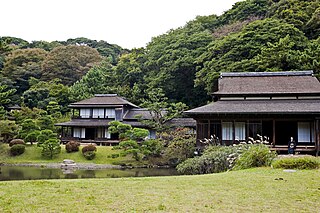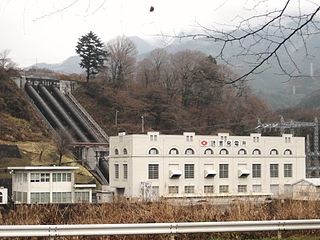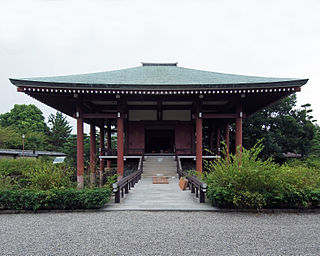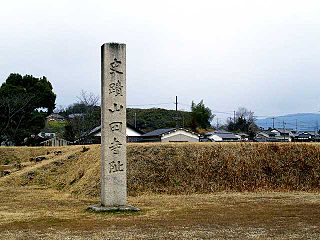This list is of Japanese structures dating from the Nara period (710–794) that have been designated Important Cultural Properties (including *National Treasures). [1] Twenty-three surviving sites with the same number of component structures have been so designated. [2] All but three are National Treasures and all but one is in Nara Prefecture. Fourteen are located in the city of Nara; those at Tōdai-ji, Gangō-ji, Tōshōdai-ji, and Yakushi-ji form part of the UNESCO World Heritage Site Historic Monuments of Ancient Nara. [3] Six are at Hōryū-ji, part of the World Heritage Site Buddhist Monuments in the Hōryū-ji Area. [4]

Tōshōdai-ji (唐招提寺) is a Buddhist temple of the Risshū sect in the city of Nara, in Nara Prefecture, Japan. The Classic Golden Hall, also known as the kondō, has a single story, hipped tiled roof with a seven bay wide facade. It is considered the archetype of "classical style".

Kōfuku-ji is a Buddhist temple that was once one of the powerful Seven Great Temples in the city of Nara, Japan. The temple is the national headquarters of the Hossō school.

A National Treasure is the most precious of Japan's Tangible Cultural Properties, as determined and designated by the Agency for Cultural Affairs. A Tangible Cultural Property is considered to be of historic or artistic value, classified either as "buildings and structures" or as "fine arts and crafts." Each National Treasure must show outstanding workmanship, a high value for world cultural history, or exceptional value for scholarship.
Daibutsu or 'giant Buddha' is the Japanese term, often used informally, for large statues of Buddha. The oldest is that at Asuka-dera (609) and the best-known is that at Tōdai-ji in Nara (752). Tōdai-ji's daibutsu is a part of the UNESCO World Heritage Site Historic Monuments of Ancient Nara and National Treasure.

The Nara National Museum is one of the pre-eminent national art museums in Japan.

Hokki-ji or Hōki-ji – formerly known as Okamoto-dera (岡本寺) and Ikejiri-dera (池後寺) – is a Buddhist temple in Okamoto, Ikaruga, Nara Prefecture, Japan. The temple's honorary sangō prefix is "Kōhonzan" (岡本山), although it is rarely used. The temple was constructed to honor Avalokitesvara, and an 11-faced statue of the goddess is the primary object of worship in the temple. Hokki-ji is often considered to be one of the seven great temples founded by Prince Shōtoku, but in fact the temple was not completed until some decades after his death. In 1993, it was registered together with Hōryū-ji as an UNESCO World Heritage Site under the name Buddhist Monuments in the Hōryū-ji Area.

Chūson-ji (中尊寺) is a Buddhist temple in the town of Hiraizumi in southern Iwate Prefecture, Japan. It is the head temple of the Tendai sect in Tōhoku region of northern Honshu. The temple claims it was founded in 850 by Ennin, the third chief abbot of the sect. George Sansom states Chūson-jí was founded by Fujiwara no Kiyohira in 1095. Chūson-jí was designated as a Special Historic Site in 1979 and in June 2011 was listed as a UNESCO World Heritage Site as a part of the "Historic Monuments and Sites of Hiraizumi".
The UNESCO World Heritage Site Historic Monuments of Ancient Nara encompasses eight places in the old capital Nara in Nara Prefecture, Japan. Five are Buddhist temples, one is a Shinto shrine, one is a Palace and one a primeval forest. The properties include 26 buildings designated by the Japanese Government as National Treasures as well as 53 designated as Important Cultural Properties. All compounds have been recognized as Historic Sites. The Nara Palace Site was designated as Special Historic Site and the Kasugayama Primeval Forest as Special Natural Monument. Tōdai-ji, Kōfuku-ji and the Kasugayama Primeval Forest overlap with Nara Park, a park designated as one of the "Places of Scenic Beauty" by the Ministry of Education, Culture, Sports, Science and Technology (MEXT). UNESCO listed the site as World Heritage in 1998.

Hōryū-ji is a Buddhist temple that was once one of the powerful Seven Great Temples, in Ikaruga, Nara Prefecture, Japan. Its full name is Hōryū Gakumonji (法隆学問寺), or Learning Temple of the Flourishing Law, the complex serving as both a seminary and monastery.

The UNESCO World Heritage Site Shrines and Temples of Nikkō encompasses 103 buildings or structures and the natural setting around them. It is located in Nikkō, Tochigi Prefecture, Japan. The buildings belong to two Shinto shrines and one Buddhist temple (Rinnō-ji). Nine of the structures are designated National Treasures of Japan while the remaining 94 are Important Cultural Properties. UNESCO listed the site as World Heritage in 1999.

The UNESCO World Heritage Site Buddhist Monuments in the Hōryū-ji Area includes a variety of buildings found in Hōryū-ji and Hokki-ji in Ikaruga, Nara Prefecture, Japan. These buildings were designated in 1993 along with the surrounding landscape, under several criteria. The structures inscribed are some of the oldest extant wooden buildings in the world, dating from the 7th to 8th centuries. Many of the monuments are also National Treasures of Japan, and reflect an important age of Buddhist influence in Japan. The structures include 21 buildings in the Hōryū-ji East Temple, 9 in the West Temple, 17 monasteries and other buildings, and the pagoda in Hokki-ji.

A Cultural Property is administered by the Japanese government's Agency for Cultural Affairs, and includes tangible properties ; intangible properties ; folk properties both tangible and intangible; monuments historic, scenic and natural; cultural landscapes; and groups of traditional buildings. Buried properties and conservation techniques are also protected. Together these cultural properties are to be preserved and utilized as the heritage of the Japanese people.

An Important Cultural Property is an item officially classified as Tangible Cultural Property by the Japanese government's Agency for Cultural Affairs and judged to be of particular importance to the history, arts, and culture of the Japanese people.

A Tangible Cultural Property as defined by the Japanese government's Law for the Protection of Cultural Properties is a part of the Cultural Properties of high historical or artistic value such as structures, paintings, sculptures, handicrafts, calligraphic works, ancient books, historic documents, archeological artifacts and other such items created in Japan. All objects which are not structures are called "works of fine arts and crafts.

Chūgū-ji (中宮寺) is a temple in Nara Prefecture, Japan, that was founded as a nunnery in the seventh century by Shōtoku Taishi. Located immediately to the northeast of Hōryū-ji, its statue of Miroku and Tenjukoku mandala are National Treasures.

Yamada-dera (山田寺) was a Buddhist temple established in the Asuka period in Sakurai, Nara Prefecture, Japan. The area has been designated a Special Historic Site and forms part of a grouping of sites submitted in 2007 for future inscription on the UNESCO World Heritage List: Asuka-Fujiwara: Archaeological sites of Japan’s Ancient Capitals and Related Properties. Excavations in the 1980s uncovered a well-preserved section of the temple's covered corridors that predate the surviving buildings of Hōryū-ji: "for the history of Japanese architecture, this discovery is of as great moment as the finding of the seventh-century Takamatsuzuka tomb paintings in March 1972 was for the history of Japanese art."